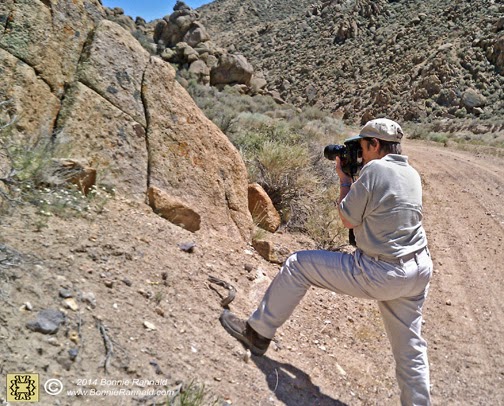Part II, What's Blooming on Rabbit Springs Road
Part two on my discoveries of wildflowers along the Gabbs Valley Range takes me back to Rabbit Springs Road from the side trip to Benton Spring. While driving a short distance, to my disappointment I began to notice that this area appeared very dry. Most of the moisture from any clouds just happens to become stalled over the Gabbs--Reese River area; however weather patterns in this portion of the Great Basin Desert can be quite unpredictable and also fickle.
I was beginning to fear that the lack of moisture was not going to allow for many wildflowers on this trip. As I was driving higher up and to the north on Rabbit Springs Road, I saw my first indication with a few small white petals of Spreading Phlox. This plant can grow to become so dense that the tiny flowers completely cover the leaves. Spreading Phlox mounds rarely grow higher than 4 inches above the ground. Maybe my luck was about to change and I would find more flowers as I drove up higher.
While walking around the area of the Spreading Phlox, my eyes were drawn to something red against the green needles of a pinyon pine. A closer look found just the one Desert Paintbrush, but what a striking scene it made with the pine needles. The Desert or Indian Paintbrush has brilliantly colored, torch-like flower spikes that range from electric pint to scarlet red. Growing on sagebrush slopes, the Paintbrush adapts by hooking its roots to the roots of a host plant.
The Pinyon Pine is a low, bushy evergreen that can reach a height of 15 to 35 feet, (4.6-10.7 m) and has adapted well in the high desert soil. Producing the edible pine nuts, the seeds are still collected by Native Americans for both cultural and economic purposes.
Gaining higher altitude, around 7,000 feet (2133.6 m) were a nice grouping of Silvery Lupines accenting the road-side with their deep blue-violet blooms. A member of the pea family, Lupines are found in rocky soils at 7,000 to 10,000 feet (2,134--3,048 m) elevation. A note of caution--the genus Lupins and especially the seeds are toxic to humans and animals if ingested.
Mixed in with the Silvery Lupines was an occasional Dwarf Lupine.
After reaching the higher altitudes more varieties of wildflowers were coming in view. The lavender flowers of a Crescent Milk-vetch were just starting to bloom. Preferring sandy or gravelly soils, this interesting plant is also known as Locoweed and comes with a word of caution as it is toxic to both humans and animals. When ingested, a disorder known as locoism will result. Locoism occurs chiefly among sheep, horses and cattle and is characterized by weakness, impaired vision, paralysis and irregular behavior.
Just as I was driving past, I noticed the tall, deep purple blossoms of a Subalpine Larkspur. The showy flower grows along shady, subalpine streams and meadow edges so I was curious as to why it was on the bank of this rocky dirt road. This plant too comes with a warning and contains toxins if eaten which can be fatal to both humans and animals.
My drive had now taken me to the mountain pass and it was time to turn around.
The interesting aspect of outdoor photography along a trail is that everything looks different on the trip back. The lavender trumpet flowers of Purple Mat were blooming off to the side. Purple Mat has been known to carpet the desert floor with ample rain.
A little further on, the white Desert Pincushions were just starting to bloom. These small multiple flowerheads accent the slopes, hillsides and shrublands in many areas of the Great Basin Desert.
The last group of wildflowers to my delight was a bunch of Spreading Fleabane nestled against rust colored sandstone rocks. The small daisy-like blossoms are short-lived, so this was a very exciting finale for a day of wildflower photos.
What
an exciting and interesting photo-adventure this day has been. I love
it when I am drawn to an area and not knowing what to expect I get
treated to new experiences.
Sign up and follow my blog to see where my next photo-adventure will be!
Photography places me in the moment where I can share that moment in time. It becomes a life story as represented by my interaction with the scene. The happiness and beauty or the sorrow and strife; how I focus leaves a lasting impression that might touch the viewer on a spiritual level.
"Reflecting Nature's Artistry"
No images on this blog are within Public Domain or are available for free download.
All rights reserved, world-wide and images protected by Digital
Millennium Copyright Act (DMCA). All photography, graphics, text,
design, and content is copyrighted by Bonnie Rannald and should not be
copied, down-loaded, transferred and re-created in any way without the
express consent, in writing to Bonnie Rannald.
For information on Bonnie Rannald licensed, right-managed images, please
submit a written request.













No comments:
Post a Comment
I welcome your response or feedback to this post. Please leave your comment below and share my Photo-Adventures with your family and friends. Subscribe to my blog and follow me on Facebook.